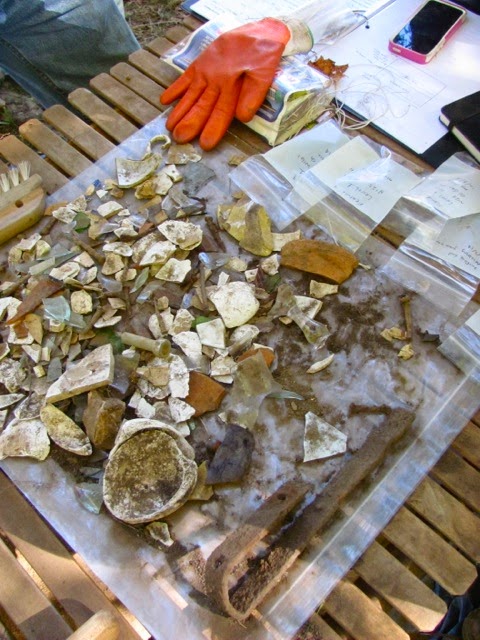I was in class during Field Day 4, but received an overview from Laurie, who led that day's excavation in Feature 4B. She, Tricia, and Andy continued to excavate Level 1, in which they found more nails, slate, stencil-painted glass, and a one-inch fragment of a pipe stem. We continued Feature 4B today, but I'll discuss our findings in my next post. Field Day 5 took place in Feature 9, back in the dump site, where we have continued to make continuous and very exciting finds.
Before I get to that, a note on the cast-iron cap gun that we found last week. I should have mentioned it, because Bruce mentioned it at the time it was found, but the gun has a seam running along the underside of the barrel, which Bruce said would not be present in a real derringer. He agrees with JJ that real derringers would traditionally be carried by women or as a backup weapon. I am still unsure about the social and cultural implications of a child in the 1880s playing with a toy modeled after a derringer. Why would a child have wanted to play with a toy derringer instead of, as JJ mentioned, a Western-style revolver?
We didn't find any more children's toys in Feature 9, but we did find a fishing hook. Remember Kirby Pond? Well, if you don't, it was the large body of water (about 100 acres according to one account) that covered what is now a park across the road from the cemetery. This seems the most likely explanation for the presence of a fishing hook in the dump site.
Throughout the morning Bruce did most of the digging, while village historian Harry McCartney and I sorted through artifacts. This was the result: lots and lots of ceramic sherds, clam and oyster shells, bottle glass, bricks, nails, and various unidentified metal objects. Not pictured (or kept): slag, coal, charcoal, and walnuts.
As always, there were a few stand-out artifacts. One of them was the bottom of a glass bottle with a pontil mark - the second example of blown glass we have identified at the site. The first, as you may recall, was found in Feature 8 on Field Day 3. In this example, which appears to be part of a medicine bottle, the glass is much thicker than the very thin and delicate glass of the first example.
Also notable: these ceramic pieces which are a match for some found in Feature 5 last year. At first look I thought they were transfer-printed, but now I'm not so sure. They may be hand-painted. The decoration with a hatched background looks transfer-printed, but the little flowers on the sherd in the upper left corner look hand-painted. I'll have to look at them more closely. For now, what do you think?
I am more certain that these are transfer-printed, and there's not much remarkable about them except that I found them very pretty. The variety of decorated ceramics we have found in the dump site has been remarkable.
While Bruce, Harry, and I dug, sorted, and bagged artifacts, Laurie and several others - including Hans, Tricia, and Dick Schmitt - worked on the gravestones in the front of the cemetery, resetting several children's graves to their original places as indicated in the WPA map.
All in all, we made good progress, finishing the excavation of the 3' x 5' Feature 9 and then backfilling it. When we return to the dump, we plan to move north and east of Feature 9, closer to the location of Feature 5. Oh, and I nearly forgot - we believe we have found two additional pieces of the Brown Betty teapot in Feature 9. Further analysis awaits.








The cap gun:
ReplyDeleteMaybe it was owned by a little girl who preferred playing 'hanging around the casino' to 'head 'em off at the pass.'
Why do you think the flowers might be hand painted? Is it the uneven thickness of the lines? I suppose it's important to know for dating purposes. Although I was brought up surrounded by ceramics of all sorts, I'm sure you know a lot more about the subject than I do. I wish you could see my 18th century Wedgwood urn. It's in terrible condition.
The fishing hook looks rather too big to have been used in a lake. Few freshwater fish have a mouth large enough, except maybe pike and they're generally considered inedible. That thing looks about the right size for bigger sea fish like conger eel and tuna.
Like the pen. Well posed.
Yes, it's the unevenness of the lines and the fact that the little dots aren't exactly centered that makes me think they might have been hand-painted. Basically, the decoration looks less exacting and less intricate than the stencil-painted patterns I'm used to seeing. I took another look at the pieces this weekend and have reaffirmed my uneducated theory that parts were hand-painted and parts were stencil-printed. I don't know that I necessarily know more about the subject than you do.
ReplyDeleteBruce made the same remark that you did about the size of the fishing hook. But then he noted that perhaps older fishing hooks (i.e. 19th century) were bigger than the ones used today (I may be misquoting him). But I suppose we aren't that far from sources of saltwater fish around here.